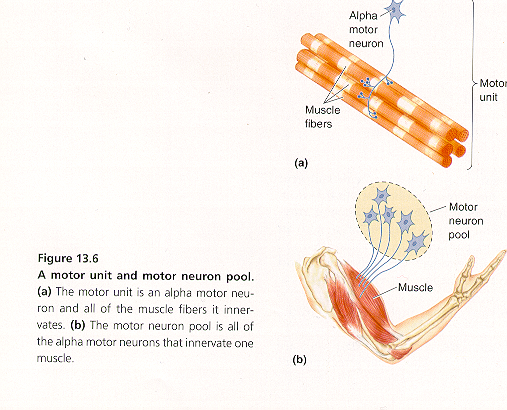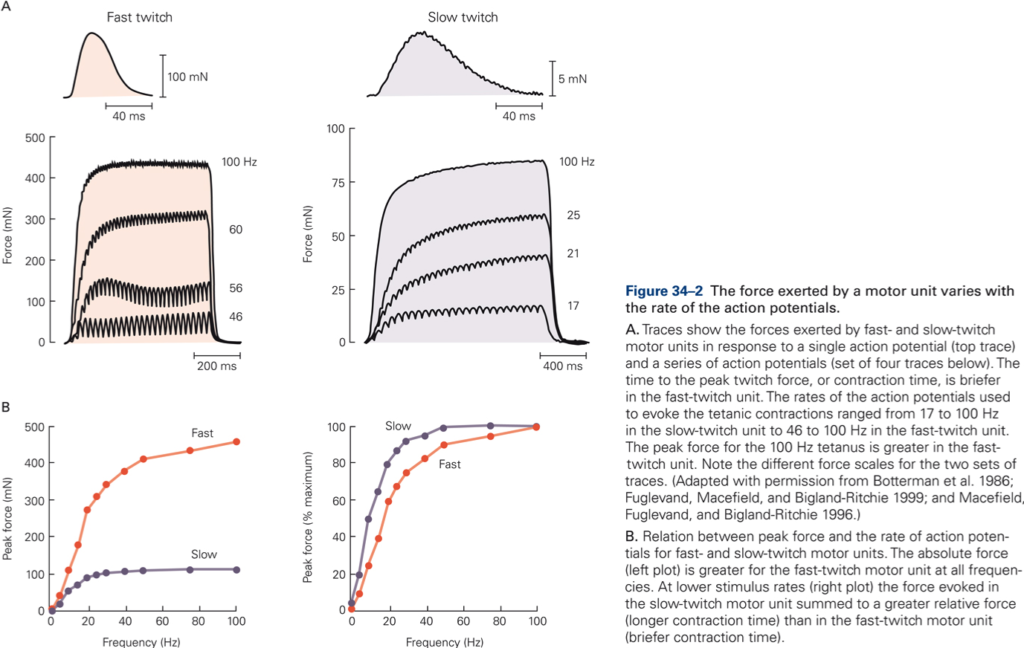Spinal Mechanisms for Sensorimotor Integration
Motor Neurons & Muscles
Definitions
Motor neuron (MN)
Neuron that innervates muscle fibers. The cell bodies and dendrites of MNs are in brainstem or spinal cord and are organized in motor neuron pools = group of MNs that innervate a given (single) muscle. The axons of one or more MN pools form a nerve. The axon of a motor neuron divides into many branches; each branch forms a single junction with a muscle fiber. Each muscle fiber is controlled by only one MN but each MN innervates many muscle fibers. All muscle fibers innervated by a single MN contract in response to an action potential in the MN. MNs receive input from all levels of the motor system. Therefore, it is through the activity of MNs that the nervous system directly regulates the force of muscle contraction.

Motor unit (MU)
A single MN and all muscle fibers it innervates. A motor unit is the smallest functional unit within the motor system.
Innervation ratio
The number of muscle fibers innervated by a single MN. The innervation ratio is different for different muscles but is roughly proportional to the size of the muscle. The smaller the innervation ratio, the more finely the nervous system can grade the total force produced by the muscle. For example, in human extraocular muscles (very small), innervation ratios are about 10; in hand muscles ~100, and in large muscles, like gastrocnemius, ratios can be as high as 2,000.
Regulation of muscle force
The motor system can grade the force of muscle contraction in two ways:
Rate modulation
Variations in the firing rate of a motor neuron: the higher the firing rate, the higher the force produced. An individual action potential lasts only ~1 ms whereas the contraction and relaxation time of a muscle twitch, which is defined as a brief contraction generated by a single action potential, lasts from 10-100 ms. An increased firing rate allows forces of corresponding twitches to summate. If the muscle is not allowed to relax between action potentials, the forces produced by each twitch add until a plateau is reached, called tetanus. Depending on the degree of summation of force we can distinguish two forms of tetanus.
Unfused tetanus
At relatively low firing rates, successive action potentials activate the muscle fibers after the peak force of each twitch, so that individual twitches are still visible. This produces characteristic ripple in the force record of the muscle.
Fused tetanus
At higher firing rates individual twitches can no longer be distinguished
Firing rates of motor neurons stay in a relatively narrow range. During steady voluntary muscle contractions rates are ~ 8 impulses/s. During strong contractions rates increase to ~25 imp/s. Therefore, rate modulation as a mechanism by which the nervous system can regulate muscle force is not as important as the second mechanism, recruitment.

Recruitment
Increasing muscle force by increasing the number of motor units that are activated.
Motor unit types
Because all muscle fibers that belong to a given motor unit have the same physiological and biochemical properties, motor units can be classified according to these properties. We can distinguish three MU types on the basis of two properties: 1) the time the different fibers take to reach peak force during a twitch, and 2) the rate at which they fatigue.
Fast twitch
These MUs contract and relax rapidly (20-50 ms) and generate the largest forces during a twitch or tetanic contraction. They are fatiguable (FF) or fatigue-resistant (FR).
Slow twitch
These MUs have longer contraction times (60-110 ms) and generate only small forces. They are highly resistant to fatigue.
Size principle
When a motor neuron pool is activated MNs are recruited in a fixed order: the smallest cell bodies are recruited first, by the weakest stimuli because they have the lowest thresholds. As the synaptic input increases in strength, progressively larger MNs are recruited. This ranking of recruitment is called recruitment according to the size principle. Motor units with smaller twitch tensions are associated with smaller motor neurons, that have smaller diameter axons that conduct action potential more slowly, and have lower thresholds of activation. Motor units with large twitch tensions (FR and FF) are associated with larger MNs that have larger diameter axons that conduct action potentials faster, and have higher thresholds.
Order of recruitment according to the size principle has several functional consequences:
- Orderly recruitment simplifies the task of controlling muscle force. Higher centers only need to vary the overall level of excitation to the MN pool and do not have to select specific combinations of MUs.
- The more numerous slower MUs are the most heavily used and must be provided with the greatest metabolic support.
In most muscles, rate modulation of the earliest recruited MUs occurs at the same time as new MUs are being recruited: recruitment and rate modulation occur simultaneously
Different muscles have different physiological roles
Muscles have varying proportions of MU types that make them better suited for different physiological functions.
Slow twitch motor units usually produce small twitch tensions and have lower innervation ratios (# muscle fibers/MU). Predominate in muscles that are active at relatively low force levels for long periods of time, such as postural muscles (e.g. soleus). Slow twitch MUs fire at low firing rates. Low firing rates produce unfused tetanus in individual muscle fibers but the total muscle contracts smoothly because not all motor units are activated at the same time. Thus, MUS are activated asynchronously to produce a finely graded change in force.
Fast twitch motor units produce high tension and have higher innervation ratios. Predominate in muscles (e.g. gastrocnemius) that are activated for short periods of time when higher force levels are required (e.g. during running and jumping). Thus, during a power burst, fast twitch MUs are activated in addition to the slow twitch MUs. The slow twitch MUs conduct slowly but get recruited first. The fast twitch MUs conduct faster but get recruited later. Thus, MUs are activated synchronously to produce a power burst.

